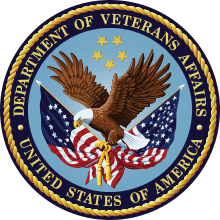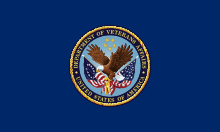United States Department of Veterans Affairs
|
Seal of the Department of Veterans Affairs | |
|
Flag of the Department of Veterans Affairs | |
 Washington DC Headquarters | |
| Agency overview | |
|---|---|
| Formed |
July 21, 1930 (Cabinet rank March 15, 1989) |
| Preceding agency |
|
| Jurisdiction | United States federal government |
| Headquarters |
810 Vermont Avenue NW., Washington, D.C., U.S. 38°54′3.25″N 77°2′5.36″W / 38.9009028°N 77.0348222°WCoordinates: 38°54′3.25″N 77°2′5.36″W / 38.9009028°N 77.0348222°W |
| Employees | 312,841 (2013) |
| Annual budget | $78.4 billion (2013) |
| Agency executives | |
| Child agency |
|
| Website |
www |
The United States Department of Veterans Affairs (VA or DVA) is a government-run military veteran benefit system with Cabinet-level status. While veterans benefits have been provided since the Revolutionary War, the Veterans Administration itself was founded in 1930, and became the cabinet-level Department of Veterans Affairs in 1989.
With a total 2009 budget of about $87.6 billion, VA employs nearly 345,000 people at hundreds of Veterans Affairs medical facilities, clinics, and benefits offices and is responsible for administering programs of veterans’ benefits for veterans, their families, and survivors. In 2012, the proposed budget for VA was $132 billion.[1] VA 2014 budget request for 2014 was $152.7 billion. This included $66.5 billion in discretionary resources and $86.1 billion in mandatory funding. The discretionary budget request represented an increase of $2.7 billion, or 4.3 percent, over the 2013 enacted level.[2]
It is administered by the United States Secretary of Veterans Affairs.

History
Continental Congress
The Continental Congress of 1776 encouraged enlistments during the American Revolutionary War by providing pensions for soldiers who were disabled. Direct medical and hospital care given to veterans in the early days of the U.S. was provided by the individual states and communities. In 1811, the first domiciliary and medical facility for veterans was authorized by the federal government, but not opened until 1834. In the 19th century, the nation's veterans assistance program was expanded to include benefits and pensions not only for veterans, but also their widows and dependents.
After the American Civil War
After the end of the American Civil War in 1865, many state veterans' homes were established. Since domiciliary care was available at all state veterans homes, incidental medical and hospital treatment was provided for all injuries and diseases, whether or not of service origin. Indigent and disabled veterans of the Civil War, Indian Wars, Spanish–American War, and Mexican Border period as well as discharged regular members of the Armed Forces were cared for at these homes.
World War I
Congress established a new system of veterans benefits when the United States entered World War I in 1917. Included were programs for disability compensation, insurance for servicepersons and veterans, and vocational rehabilitation for the disabled. By the 1920s, the various benefits were administered by three different federal agencies: the Veterans Bureau, the Bureau of Pensions of the Interior Department, and the National Home for Disabled Volunteer Soldiers.
The establishment of the Veterans Administration came in 1930 when Congress authorized the president to "consolidate and coordinate Government activities affecting war veterans". The three component agencies became bureaus within the Veterans Administration. Brigadier General Frank T. Hines, who directed the Veterans Bureau for seven years, was named as the first Administrator of Veterans Affairs, a job he held until 1945.
World War II
The close of World War II resulted in not only a vast increase in the veteran population, but also a large number of new benefits enacted by Congress for veterans of the war. In addition, during the late 1940s, the VA had to contend with aging World War I veterans. During that time, "the clientele of the VA increased almost fivefold with an addition of nearly 15,000,000 World War II veterans and approximately 4,000,000 World War I veterans".[3] Prior to World War II, in response to scandals at the Veterans Bureau, programs that cared for veterans were centralized in Washington, D.C. This centralization caused delays and bottlenecks as the agency tried to serve the World War II veterans. As a result, the VA went through a decentralization process, giving more authority to the field offices.[4]
The World War II GI Bill was signed into law on June 22, 1944, by President Franklin D. Roosevelt.[5]
"The United States government began serious consolidated services to veterans in 1930. The GI Bill of Rights, which was passed in 1944, had more effect on the American way of life than any other legislation - with the possible exception of the Homestead Act."[6]
The VA health care system has grown from 54 hospitals in 1930 to include 153 medical centers; more than 700 outpatient, community, and outreach clinics; 126 nursing home care units; and 35 domiciliaries. VA health care facilities provide a broad spectrum of medical, surgical, and rehabilitative care. The responsibilities and benefits programs of the Veterans Administration grew enormously during the following six decades.
Korean War through 2001
Further educational assistance acts were passed for the benefit of veterans of the Korean War, the Vietnam Era, the introduction of an "all-volunteer force" in the 1970s (following the end of conscription in the United States in 1973), the Persian Gulf War, and those who served following the attacks of September 11, 2001.
The Department of Veterans Affairs Act of 1988 (Pub.L. 100–527) changed the former Veterans Administration, an independent government agency established in 1930, primarily to see to the needs of World War I veterans, into a Cabinet-level Department of Veterans Affairs. It was signed into law by President Ronald Reagan on October 25, 1988, but actually came into effect under the term of his successor, George H. W. Bush, on March 15, 1989.
The Department of Veterans Affairs was created due to nearly one third of the population being eligible for veterans benefits. Its proponents argued that due to the large number of Americans affected by the VA, it needed an administrator who had direct access to the president.[7]
In their major reform period of 1995–2000, the Veterans Health Administration (VHA) implemented universal primary care, closed 55% of their acute care hospital beds, increased patients treated by 24%, had a 48% increase in ambulatory care visits, and decreased staffing by 12%. By 2000, the VHA had 10,000 fewer employees than in 1995 and a 104% increase in patients treated since 1995, and had managed to maintain the same cost per patient-day, while all other facilities' costs had risen over 30% to 40% during the same period.
Veterans Health Administration scandal of 2014
In May 2014, major problems with scheduling timely access to medical care became public. As of May 2014, at least 40 United States Armed Forces veterans died waiting for care at the Phoenix, Arizona Veterans Health Administration facilities, and an investigation of delays in treatment throughout the Veterans Health Administration system is being conducted by the Veterans Affairs Inspector General.[8][9] On May 30, 2014, Secretary of Veterans Affairs Eric Shinseki resigned from office due to the fallout from the scandal,[10] saying he couldn't explain the lack of integrity among some leaders in VA healthcare facilities. "That breach of integrity is irresponsible, it is indefensible, and unacceptable to me. I said when this situation began weeks to months ago that I thought the problem was limited and isolated because I believed that. I no longer believe it. It is systemic. I was too trusting of some and I accepted as accurate reports that I now know to have been misleading with regard to patient wait times," Shinseki said in a statement. He said he could not defend what happened because it was indefensible, but he could take responsibility for it and he would.[11]

Functions
The VA's primary function is to support veterans in their time after service by providing benefits and support. A current initiative in the Department is to prevent and end veterans' homelessness.[12] The VA works with the United States Interagency Council on Homelessness to address these issues. The Secretary sits on the Council and is committed to ending veterans' homelessness by 2015 as laid out in Opening Doors: Federal Strategic Plan to Prevent and End Homelessness, released in 2010.[13]
Organization
The Department of Veterans Affairs is headed by the Secretary of Veterans Affairs, appointed by the President with the advice and consent of the Senate.
The current Secretary of Veterans Affairs is Robert A. McDonald. The third listed executive on the VA's official web site is its Chief of Staff (currently Jose D. Riojas); the Chief of Staff position does not require Senate confirmation. In addition to Secretary and Deputy Secretary, the VA has at least nine more positions requiring presidential appointment and Senate approval.
The Department has three main subdivisions, known as Administrations, each headed by an Undersecretary:
- Veterans Health Administration (VHA): responsible for providing health care in all its forms, as well as for biomedical research (under the Office of Research and Development), Community Based Outpatient Clinics (CBOCs), and Regional Medical Centers
- Veterans Benefits Administration (VBA): responsible for initial veteran registration, eligibility determination, and five key lines of business (benefits and entitlements): Home Loan Guarantee, Insurance, Vocational Rehabilitation and Employment, Education (GI Bill), and Compensation & Pension
- National Cemetery Administration: responsible for providing burial and memorial benefits, as well as for maintenance of VA cemeteries
There are Assistant Secretaries of Veteran Affairs for: Congressional and Legislative Affairs; Policy and Planning; Human Resources and Administration; and Operations, Security and Preparedness. Other Senate-approved presidential nominees at the VA include: Chief Financial Officer; Chair, Board of Veterans' Appeals; General Counsel; and Inspector General.[14]
Benefits
The VA, through its Veterans Benefits Administration (VBA), provides a variety of services for veterans including disability compensation, pension, education, home loans, life insurance, vocational, rehabilitation, survivors’ benefits, health care, and burial benefits.[15]
The Department of Labor (DOL) provides job development and job training opportunities for disabled and other veterans through contacts with employers and local agencies such as this one.[16]
Costs for care
As is common in any time of war, recently there has been an increased demand for nursing home beds, injury rehabilitation, and mental health care. The VA categorizes veterans into eight priority groups and several additional subgroups, based on factors such as service-connected disabilities, and their income and assets (adjusted to local cost of living).
Veterans with a 50% or higher service-connected disability as determined by a VA regional office “rating board” (e.g., losing a limb in battle, PTSD, etc.) are provided comprehensive care and medication at no charge. Veterans with lesser qualifying factors who exceed a pre-defined income threshold have to make co-payments for care for non-service-connected ailments and pay $9 per 30-day supply for each prescription medication. VA dental and nursing home care benefits are more restricted.

Reservists and National Guard personnel who served stateside in peacetime settings or have no service-related disabilities generally do not qualify for VA health benefits.[17]
The VA's budget has been pushed to the limit in recent years by the War on Terrorism.[18] In December 2004, it was widely reported that VA’s funding crisis had become so severe that it could no longer provide disability ratings to veterans in a timely fashion.[19] This is a problem because until veterans are fully transitioned from the active-duty TRICARE healthcare system to VA, they are on their own with regard to many healthcare costs.
The VA's backlog of pending disability claims under review (a process known as "adjudication") peaked at 421,000 in 2001, and bottomed out at 254,000 in 2003, but crept back up to 340,000 in 2005.[20]
No copayment is required for VA services for veterans with military-related medical conditions. VA-recognized service-connected disabilities include problems that started or were aggravated due to military service. Veteran service organizations such as the American Legion, Veterans of Foreign Wars, and Disabled American Veterans, as well as state-operated Veterans Affairs offices and County Veteran Service Officers (CVSO), have been known to assist veterans in the process of getting care from the VA.
In his budget proposal for fiscal year 2009, President George W. Bush requested $38.7 billion—or 86.5% of the total Veterans Affairs budget—for veteran medical care alone.
In the 2011 Costs of War report from Brown University, researchers projected that the cost of caring for veterans of the War on Terror would peak 30–40 years after the end of combat operations. They also predicted that medical and disability costs would ultimately total between $600 billion and $1 trillion for the hundreds of thousands treated by the Department of Veterans Affairs.[21]
The New GI Bill
The new GI Bill authored by Sen. Jim Webb (D-VA) doubled GI Bill college benefits while providing a 13-week extension to federal unemployment benefits. The new GI Bill doubled the value of the benefit to roughly $90,000 up from $40,000. In-state public universities essentially are covered to provide full scholarships for veterans under the new education package. For those veterans who served at least three years a monthly housing stipend was also added to the law.
Upon passage of the new GI Bill President George W. Bush stated "Our nation has no greater responsibility than to support our men and women in uniform—especially because we're at war... This bill shows the American people that even in an election year, Republicans and Democrats can come together to support our troops and their families", which highlighted that the new GI Bill had been overwhelmingly supported by both parties in the U.S. Congress.[22]
Congress and President Barack Obama extended the new GI Bill in August 2009 at the cost of roughly $70 billion over the next decade. Upon passing the GI Bill extension President Obama stated his support of the fighting forces of the United States by saying "Over the last eight years, they have endured tour after tour of duty in dangerous and distant places... They've experienced grueling combat, from the streets of Fallujah to the harsh terrain of Helmand province. They've adapted to complex insurgencies, protected local populations and trained foreign security forces."
The Pentagon worked closely with Congressional lawmakers to ensure military families were protected in the expansion of the law. In doing so, military officials worked non-stop to add a provision to extend the GI Bill to the surviving spouse and children of servicemembers killed while in combat.
This provision was highly favored by the Pentagon which authorized the Department of Defense (DoD) to allow individuals who, on or after August 1, 2009, have served at least 6 years in the Armed Forces and who agree to serve at least another 4 years in the U.S. Armed Forces to transfer unused entitlement to their surviving spouse. Servicemembers reaching 10 year anniversaries could choose to transfer the benefit to any dependent(s) (spouse, children).[23]
National Cemetery Administration
In 1973, the Veterans Administration assumed another major responsibility when the National Cemetery System (NCS) (except for Arlington National Cemetery) was transferred to the Veterans Administration from the Department of the Army.
In 1978, Congress established the State Cemetery Grants Program (Public Law 95-476). This act is administered by the National Cemetery Administration to aid States and U.S. territories in the establishment, expansion and improvement of veterans cemeteries.[24] The VA was charged with the operation of the NCS, including the marking of graves of all persons in national and State cemeteries (and the graves of veterans in private cemeteries, upon request) as well and administering the State Cemetery Grants Program. The VA's National Cemetery Administration maintains 131 national cemeteries in 39 states (and Puerto Rico) as well as 33 soldier's lots and monument sites.
The Department of the Army maintains two national cemeteries, the Arlington National Cemetery and the U.S. Soldiers' & Airmen's Home National Cemetery. Many states have established state veterans cemeteries. The American Battle Monuments Commission maintains 25 overseas military cemeteries that serve as resting places for almost 125,000 American war dead; on Tablets of the Missing that memorialize more than 94,000 U.S. servicemen and women; and through 25 memorials, monuments and markers. Fourteen national cemeteries are maintained by the National Park Service.
Freedom of Information Act processing performance
In the latest Center for Effective Government analysis of 15 federal agencies which receive the most Freedom of Information Act (United States) (FOIA) requests, published in 2015 (using 2012 and 2013 data, the most recent years available), the VA earned a D by scoring 64 out of a possible 100 points, i.e. did not earn a satisfactory overall grade.[25]
Labor Force
The VA employs nearly 280,000 people who serve 21.6 million U.S. veterans. Approximately 204,000 VA employees are represented by the American Federation of Government Employees, with VA matters addressed in detail by the National VA Council.
Related legislation
- 1944: Mustering-out Payment Act PL 78-225
- 1944: Servicemen’s Readjustment Act PL 78-346
- 1944: Veterans' Preference Act PL 78-359
- 1952: Veterans' Readjustment Assistance Act PL 82-550
- 1974: Vietnam Veterans' Readjustment Assistance Act
- 1988: Department of Veterans Affairs Act PL 100-527
- 2006: Veterans Benefits, Health Care, and Information Technology Act of 2006 PL 109-461
- 2013: FOR VETS Act of 2013 Pub.L. 113–26
- 2013: Veterans Paralympic Act of 2013 (H.R. 1402; 113th Congress) Pub.L. 113–59
- 2014: Veterans Access, Choice, and Accountability Act of 2014 (H.R. 3230; 113th Congress) Pub.L. 113–146
Proposed
- 2013: To establish a commission or task force to evaluate the backlog of disability claims of the Department of Veterans Affairs (H.R. 2189; 113th Congress)
- 2013: Demanding Accountability for Veterans Act of 2013 (H.R. 2072; 113th Congress)
- 2014: Department of Veterans Affairs Management Accountability Act of 2014 (H.R. 4031; 113th Congress)
See also
- Benefits for US Veterans with PTSD
- DD Form 214
- Department of Veterans Affairs Under Secretary's Award in Health Services Research
- EBenefits
- List of veterans' organizations
- Old soldiers' home
- United States Department of Veterans Affairs Police
- United States military veteran suicide
- Veterans Health Information Systems and Technology Architecture (VistA)
Notes and references
- ↑ Office of Public and Intergovernmental Affairs (2011-02-14). "News Releases - Office of Public and Intergovernmental Affairs". Va.gov. Retrieved 2014-08-01.
- ↑ Office of Budget (2014-03-07). "Annual Budget Submission - Office of Budget". Va.gov. Retrieved 2014-08-01.
- ↑ Kammerer, Gladys 1948. "The Veterans Administration in Transition". Public Administration Review Vol. 8, No. 2, pp 104.
- ↑ Kammerer, Gladys 1948. "The Veterans Administration in Transition". Public Administration Review Vol. 8, No. 2, pp. 103–109.
- ↑ "Welcome to". Ourdocuments.gov. Retrieved 2014-08-01.
- ↑ U.S. Senior Vets. "U.S. Senior Vets, Serving Those Who Sacrificed, Veterans Aid and Attendance". Usseniorvets.com. Retrieved 2014-08-01.
- ↑ http://www.va.gov/opa/publications/archives/docs/history_in_brief.pdf
- ↑ Scott Bronstein and Drew Griffin. "A fatal wait: Veterans languish and die on a VA hospital's secret list". CNN. Retrieved 31 May 2014.
- ↑ "Obama vows action on any VA 'misconduct'". BBC News. Retrieved 31 May 2014.
- ↑ "Veterans Secretary Eric Shinseki resigns after report". BBC News. Retrieved 31 May 2014.
- ↑ "US president accepts with 'regret' Veterans Affairs chief's resignation". Chicago Chronicle. Retrieved 31 May 2014.
- ↑ Office of Public and Intergovernmental Affairs. "Office of Public and Intergovernmental Affairs". Va.gov. Retrieved 2014-08-01.
- ↑ Opening Doors | United States Interagency Council on Homelessness (USICH). Usich.gov (2010-06-22). Retrieved on 2013-07-23.
- ↑ "Executive Biographies", Department of Veterans Affairs official web site, Retrieved 2014-05-29
- ↑ "Benefits: Links - U.S. Department of Veterans Affairs". Va.gov. 2009-03-09. Retrieved 2014-08-01.
- ↑ "New Opportunities for Veterans". New Opportunities Inc. of CT (Connecticut). 2009-03-09. Archived from the original on 2016-03-04. Retrieved 2016-06-08.
Service Area: Greater Waterbury and Greater Torrington depending on volunteer availability
- ↑ US Department of Veterans Affairs (2014-07-23). "Health Benefits Home". Va.gov. Retrieved 2014-08-01.
- ↑ Dennis Camire, “New fees, limits face ailing veterans,” Albany Times Union, 10 February 2003, A1.
- ↑ Cheryl L. Reed, “VA chief orders inspector to probe disability rating system,” Chicago Sun-Times, 11 December 2004, A3.
- ↑ Cory Reiss, "VA fighting losing battle against backlog of veterans’ claims", Sarasota Herald-Tribune, 27 May 2005, A7.
- ↑ "Caring for US Veterans". Costs of War. Brown University. Retrieved 19 July 2011.
- ↑ Feller, Ben (2008-06-30). "President Bush Signs GI Bill - ABC News". Abcnews.go.com. Retrieved 2014-08-01.
- ↑ Military.com (n.d.). "Post-911 GI Bill Transferability Fact Sheet". U.S. Department of Veterans Affairs. Retrieved 2014-08-01.
- ↑ "Veterans Memorial Cemetery | Department of Military and Veterans Affairs". www.colorado.gov. Retrieved 2016-08-31.
- ↑ Making the Grade: Access to Information Scorecard 2015 March 2015, 80 pages, Center for Effective Government, retrieved 21 March 2016
Further reading
In 1998, the Institute of Medicine began a series of studies to respond to requests from the U.S. Department of Veterans Affairs and Congress for an examination of the health effects of potentially harmful agents to which Gulf War veterans might have been exposed.
- Jan. 1, 2000: Gulf War and Health: Volume 1. Depleted Uranium, Sarin, Pyridostigmine Bromide, and Vaccines
- Feb. 18, 2003: Gulf War and Health Volume 2: Insecticides and Solvents
- Aug. 20, 2004: Gulf War and Health: Updated Literature Review of Sarin
- Dec. 20, 2004: Gulf War and Health: Volume 3. Fuels, Combustion Products, and Propellants
- Sep. 12, 2006: Gulf War and Health: Volume 4. Health Effects of Serving in the Gulf War
- Oct. 16, 2006: Gulf War and Health: Volume 5. Infectious Disease
- Nov. 15, 2007: Gulf War and Health: Volume 6. Physiologic, Psychologic, and Psychosocial Effects of Deployment-Related Stress
- Jul. 30, 2008: Epidemiologic Studies of Veterans Exposed to Depleted Uranium: Feasibility and Design Issues
- Jul. 30, 2008: Gulf War and Health: Updated Literature Review of Depleted Uranium
- Dec. 4, 2008: Gulf War and Health: Volume 7. Long-term Consequences of Traumatic Brain Injury
External links
| Wikimedia Commons has media related to United States Department of Veterans Affairs. |
- Official website
- Department of Veterans Affairs in the Federal Register
- Official blog
- VA History in Brief
- A Brief History of the VA from the Office of Facilities Management
- VA HyperFAQ directory of top VA web pages.
- Veterans Benefits Administration: An Organizational History, 1776-1994 by Knight & Worden, 1995.
- A Nation Repays Its Debt: The National Soldiers' Home and Cemetery in Dayton, Ohio, a National Park Service Teaching with Historic Places (TwHP) lesson plan
- PBS NOW | Fighting the Army
- Investing In Veterans by Eric Shinseki

